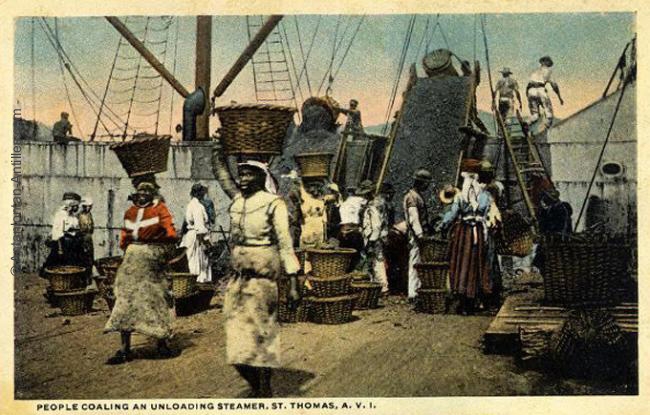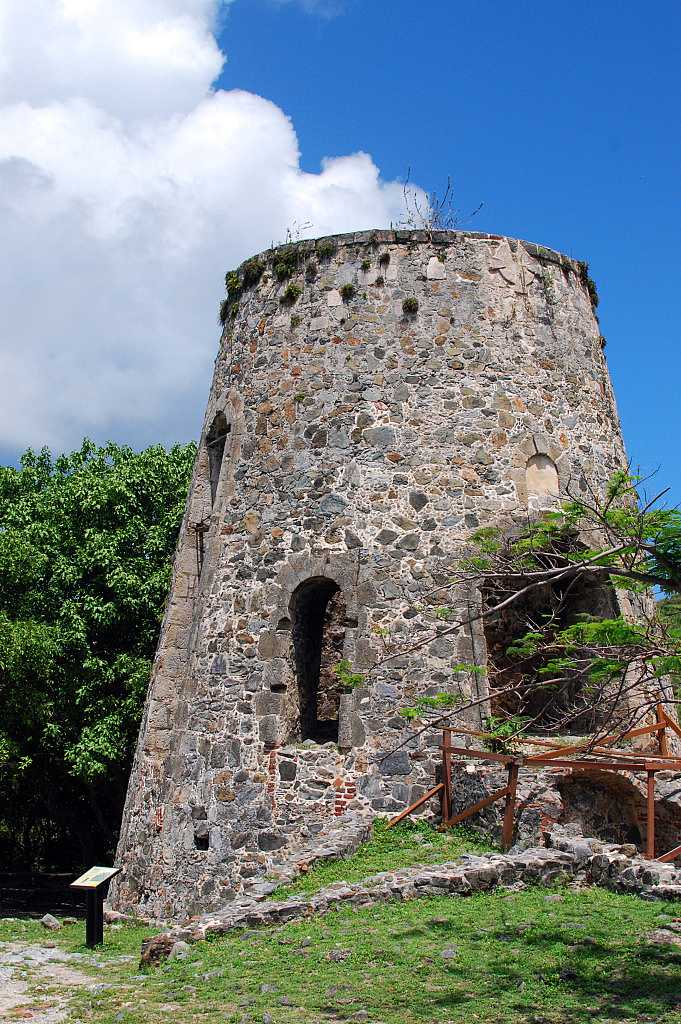
St John in the year 1914–can you imagine? That’s when Guy Benjamin was born, out on the East End of St John. History is everywhere here. There are some wonderful photos from old-time St John, but this was what things looked like over on ST Thomas to give you an idea c. 1918.
Who was Guy Benjamin? Well, when you travel out to Coral Bay ST John you’ll notice a colorful litte school there–and it’s called the Guy Benjamin School. Guy taught there–and surely had a lot to do with it getting there in the first place as he was a lifelong educator. Sadly, this school breathtakingly set to close, however.
Guy was the first St. Johnian to finish high school. He went on to graduate from New York University, and to become both Superintendent of Schools on St. John and St. Thomas and an author (Me and My Beloved Virgin) … the cover is on the cover of this post. This book is filled with stories that he remembered from those early days and maybe a few more from his vivid imagination. Guy passed in 2012, but I had the pleasure of meeting him on a few occasions–and a copy of his book is available for you to read at Mooncottage.
If you love ST John, you need to know about Guy Benjamin. One way would be to read his book, “Me and My Beloved Virgin.” He had a little broken down house just past Skinny’s where a goat would usually be sitting on the roof of his car. (Not exactly sure that it was HIS car, but it was at his house). On the street in front of his house, up until only about 3-4 years ago was a small wooden stand by the side of the road with a stack of his books for sale. All you had to do was leave your money there and take a copy. I can’t imagine anyone ever stealing one or the money–it would be a crime in Coral Bay punishable by death or worse. He was that beloved.
When I met Guy, it was probably in the year 2000–he was in his late 80’s at the time. I was busy learning about this and that when I first came to ST John myself and read his book and wanted to meet him. So I went by his house and shouted to him my arrival the true way you need to announce yourself anywhere in the Virgin Islands, “Inside, Inside!” He came to the door having just woken up from a nap and invited me in. There inside his house, there was virtually nowhere to sit … except on top of stacks of papers and books–some piled high to the ceiling. To say that Guy was not the greatest housekeeper would be an understatement, but he was a character. I think everything he ever read was still in that little wooden house.
Well, in any case, I explained to him how much I liked his book and he said immediately, “Well, in that case, let me read you a story or two to you so you can get the real feel for it.” So, he proceeded to read his book to me aloud. Most of all it in fact. With that amazing West Indian lilt. I was there mesmerized for hours. It was one of the most delightful afternoons I have ever spent on ST John. So, when he finally felt that maybe he had shared enough with me, he said with eyes gleaming, “Oh my God, you are in luck! I have a copy of the 2nd volume of My Beloved Virgin which isn’t published yet, and now I am going to read you some of those storied right now!” And, I sat there another hour or two to hear more tales of early ST John and its people.
I guess the moral of the story is this. When vacationing on ST John, remember that history is everywhere. And, sometimes it might be sitting right next to you enjoying a cool Red Stripe. Next time, I’ll tell you about a man who came to vacation on ST John who had more to think about than anyone in the world at that time–J. Robert Oppenheimer while a director at the Institute for Advanced Studies at Princeton. But, that’s another story. Guy Benjamin was a gentle and peaceful gift from another era. See if you can find his book and you’ll understand what I mean.

Sure St. John is known for its pristine beaches and incredibly romantic St. John villas like Mooncottage, but history is everywhere here and part of the romantic ambiance that keeps people coming back year after year. Every year over a million visitors come to St. John to enjoy a restful vacation, beach holiday, romantic honeymoon … you name it. But, why do they keep coming back year after year. History is a big part of the reason visitors keep coming back to St. John year after year. No place in the Caribbean is richer in romantic legend and history than St. John. Here’s just a brief synopsis.
The first human inhabitants of the Virgin Islands were the Arawak Indians. The Arawaks were descendants of coastal Indians from what is now Venezuela and Guyana who were forced out of that area by more aggressive tribes sometime around 300 AD. The Arawaks lived peacefully here, fishing and farming, until the fierce and cannibalistic Carib Indians moved into the area about 100 years before the arrival of Columbus.
Christopher Columbus “discovered” the Virgin Islands on his second voyage to the Caribbean in 1493. Because the islands were sited around the time of the feast of St. Ursula, he named them “Once Mil Virgins” after the eleven thousand virgins that were martyred with St. Ursula. Columbus was a devout Christian, and some say a religious zealot who was obsessed with the idea of converting what he thought was Asia to Christianity. But Columbus received wealth and status also.
It was under the Spanish colonists in Hispaniola that slavery began in the Caribbean. The indigenous people, both Carib and Arawak, were forced to work in Spanish mines and on farms. Conditions for them were so bad that most died of malnutrition and disease and others escaped the Spanish for temporary asylum in Cuba. In less than two decades, more than one million Indians had died or fled from the island of Hispaniola. By the time the Danes, British and French arrived in the Virgin Islands in the 17th century, the Indian populations had disappeared from there as well.
In 1585, five years after the end of his famous circumnavigation, Sir Francis Drake was in the Caribbean, once again in search of gold laden Spanish ships. Legend has it that he had a lookout from the island of St. Thomas (Drakes seat, where the view continues well to the east, into what is now the British Virgin Islands); and, that he organized his privateering flotilla in Coral Bay, St. John.
St. Thomas was settled in 1672 by agents of the Danish West India and Guinea company, but Denmark did not officially take possession of the Virgin Islands until 1754. The Danish estates on St. Thomas and St. John were planted with sugar cane, tobacco, and cotton – all very work intensive crops that would not have made a profit were it not for the labor of plantation slaves.
Slavery proliferated in the Virgin Islands until slaves out numbered Europeans on some islands by 5 to 1. Out of fear of rebellion, the Danes instituted a barbaric slave code that outlined the torture of disobedient or rebellious slaves. In September of 1733, after a summer of drought, an insect plague, two hurricanes, and the adoption of a severe and inhumane slave code, the slaves on St. John rebelled and took control of the island for six months until French troops arrived from Martinique to put down the rebellion. Rather than being captured, which would have meant death by torture, many of the rebels committed suicide at Ram’s Head. According to legend, 300 slaves jumped to their deaths from the cliffs. acknowledgement: http://www.wiol.com
Nothing is EVERY boring on romantic St. John, because history keeps reminding us how long this paradise has been in existence. And, visiting St. John now gives us a birds-eye view everything St. John has to offer and more. Enjoy!